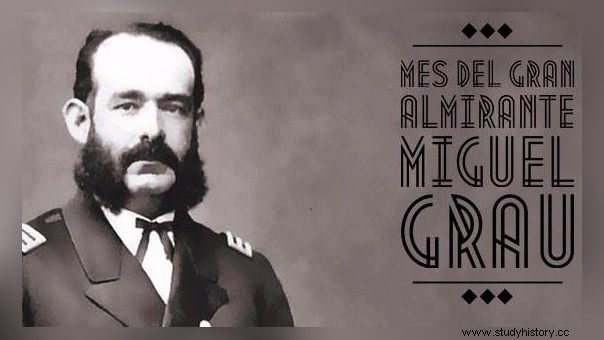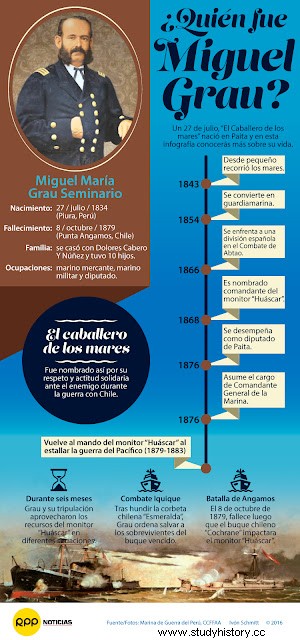Early years. At the age of 9 he went to sea in the merchant brig "Tescua" and in 1844 he began to travel on merchant ships. At only 19 years old, he became a midshipman and wore the uniform for the first time.He participated in the naval combat of Abtao (February 1866) commanding the corvette "Unión". In 1867, he retired on leave from active service in the Navy to marry Dolores Cabero Núñez, with whom he had ten children. In 1868 he rejoined being appointed commander of the "Huáscar" monitor.
 October 8 commemorates Grau's heroic deed in the Angamos battle. | Source:Navy Political participation. Miguel Grau also ventured into politics. In 1876 he was a member of the Civil Party and served as deputy for Paita, leaving the command of the "Huáscar" for two legislative periods. When the war in the Pacific broke out, he was assigned again to the command of the "Huáscar" monitor.
October 8 commemorates Grau's heroic deed in the Angamos battle. | Source:Navy Political participation. Miguel Grau also ventured into politics. In 1876 he was a member of the Civil Party and served as deputy for Paita, leaving the command of the "Huáscar" for two legislative periods. When the war in the Pacific broke out, he was assigned again to the command of the "Huáscar" monitor. "The Knight of the Seas". He is known in this way for his actions in solidarity with the enemy. On May 21, 1879, the Peruvian naval division made up of the monitor "Huáscar" and the frigate "Independencia", confronted the Chilean ships that were blockading the port of Iquique. After sinking the corvette "Esmeralda", Grau ordered the survivors of the defeated ship to be saved.
Combat of Angamos. On October 8, 1879, the Peruvian division is intercepted by Chilean forces. Grau orders the commander of the "Union" ship to save his crew, leaving only the "Huáscar" monitor. Grau dies after a grenade launched from the "Cochrane" hit the "Huáscar" monitor. The naval battle that occurred on Wednesday, October 8, 137 years ago, in the setting of the War of the Pacific, pitted the Peruvian ships Huáscar and Unión against the Chilean ships Cochrane, Blanco Encalada, Loa and Covadonga. This contest cost the life of the great admiral, who for his great character is recognized to this day, both by Chileans and Peruvians, as the Knight of the Seas
The enemy's tribute. One of the reports presented by the Chilean Commander, Galvarino Riveros, after the capture of the Huáscar and the discovery of the lifeless body of the Peruvian hero, leaves no doubt about the immense respect that the enemy squadron professed for him. "... The death of the Peruvian Rear Admiral, Mr. Miguel Grau, has been, Mr. Commander General, deeply felt in this Squadron, whose chiefs and officers did ample justice to the patriotism and courage of that remarkable sailor," says part of the document that He sent his chief officer. Grau's gesture Grau's gesture of chivalry towards Carmela Carvajal, widow of the Chilean hero Arturo Prat Chacón, commander of the corvette Esmeralda, who died on the deck of the Huáscar, is also remembered. She wrote a letter in which she praised her husband's performance and sent him some of her personal belongings, including her sword, which may well have been taken as a trophy of war.
The height of the hero. The patriotism of Miguel Grau Seminario was evident when he decided to leave his position as deputy for Paita (Piura) in Parliament to rejoin the Peruvian Navy in 1879, commanding the Huáscar. The national hero knew that in the War of the Pacific, Peru was at a disadvantage, but even so he fought bravely and was honorable with his adversaries.

Source:Peruvian Navy, Armed Forces Joint Command
